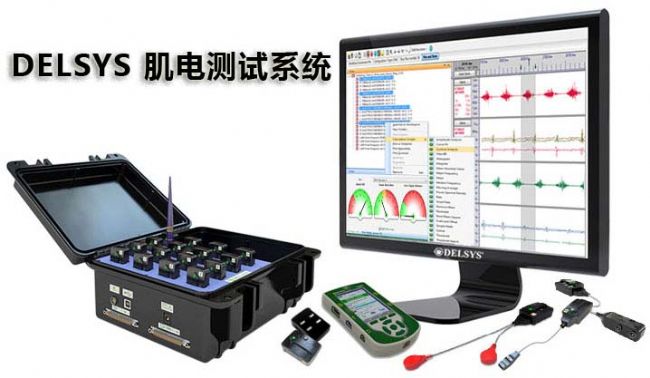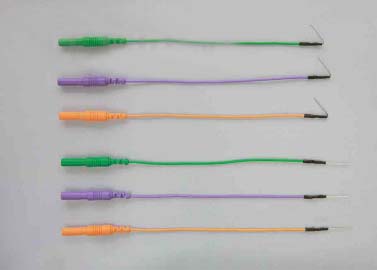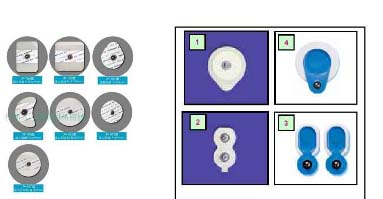Electromyography is an effective means of studying muscle activity. Piper (1912) first used the surface electrode to guide the unit of myoelectric activity during voluntary contraction. Later, Adrian and Bronk (1929) developed the activity potential of the motor unit with a concentric needle electrode, and Buchthal et al further developed Polar electrode. At present, the activity of guiding single muscle fibers with microelectrodes has been widely used both at home and abroad this year. Electrode classification: Measurement electrodes used to measure myoelectric signals can be classified into needle electrodes and surface electrodes.

Needle electrode
Needle electrodes are mostly used for clinical diagnosis and basic research.
advantage
It can measure the myoelectric activity of deep muscles, and the number of movement units involved in the needle electrode is small and more targeted. It can clearly derive the single motion potential or the potential change of a single muscle fiber, and can study the function of a certain muscle fiber in the deep muscle.
Disadvantage
1. The area tested is small and cannot reflect the functional state of the whole muscle;
2, invasive, and the position, depth and technique of the needle are very critical, and the requirements of the operator are very high;
3. It is impossible to measure changes in myoelectricity during exercise.

Surface electrode
The surface electromyography electrode is suitable for superficial skeletal muscle and can be directly applied to exercise training. The surface electrode is made of a silver-silver chloride electrode having a diameter of 1 cm or less as a guiding electrode, and the electrode is fixed on the skin of the muscle to be measured (when the muscle contracts, according to the principle of the volume conductor, the action potential can be reflected from the conductive action of the muscle fiber tissue fluid to The surface of the skin) is usually placed at the muscle abdomen or at the point of muscle movement.
Before placing the electrode, it should be noted that the skin is wiped with acetone or alcohol solution to make the skin impedance within a certain range; the electrodes are placed in parallel along the walking direction of the muscle fibers, spaced 2~3cm, and the bipolar is exported.
Volume conductor principle
Human and animal organisms have a large amount of body fluids, and body fluids can be used as volume conductors to transmit bioelectrical changes produced by muscle activity to the body surface. Therefore, placement of guide electrodes in any part of the body can be guided to the muscles through the amplifier. Activity, the recorded myoelectric curve is the EMG.

1. The advantages are convenient and easy to perform, will not cause damage, and are easily accepted by the subject;
2. The measured changes in myoelectricity can reflect changes in the function of the entire muscle;
3. It is suitable for measuring myoelectric changes during exercise.
Disadvantage
1. The induced myoelectricity is a comprehensive potential of many motor unit potentials, and the waveform is complex and inconvenient to analyze;
2. It is not possible to reflect in detail the changes in myoelectricity of a certain part of the muscle or a certain exercise unit;
3. The skin's electrical resistance is large, and the myoelectricity recorded by the surface electrode will be weakened.
The myoelectric electrode records the myoelectric activity of a region around the electrode. The muscle fiber potentials that can be recorded by the two surface electrodes are only in the range of 1-2 cm.
Therefore, it is impossible to record the electromyogram of the entire muscle with only two electrodes. To record the electromyogram of the entire muscle requires multiple aligned and multiple sets, or large areas of electrodes.
Surface array electrode
Although the sEMG signal detection method overcomes the invasiveness of the needle electrode, the traditional two-electrode sEMG can only record the integrated electrical activity of a muscle unit of a muscle, and cannot provide information on the electrical activity of muscles in different spatial positions.
In recent years, an array electrode based sEMG signal detection method has emerged.
advantage
1. The spatial distribution characteristics of muscle electrical activity can be taken by simultaneously recording electrical activity at multiple spatial locations on the muscle surface;
2. Superior performance in improving stimulation selectivity and control.
The mutual superposition and cancellation of the stimulation pulses output by different contacts can effectively enhance the stimulation intensity of the target region, and inhibit the activation of the nerve fibers in the non-target target region, thereby effectively improving the targeting performance of the electrical stimulation.
Disadvantage
The surface EMG signal is actually the superposition of the motor unit action potentials (MUAP) through the subcutaneous tissue and the skin and the surface of the skin. Therefore, compared with the needle electrode EMG, it is not conducive to distinguishing each MUAP, and its application in medical diagnosis is limited.

Dried Eggplant,Dehydrated Eggplant Slices,Dried Eggplant Round Flakes,Eggplant Powder, China Dried Eggplant
Jiangsu Tiankang Food Co., Ltd. , https://www.tiankangfood.com